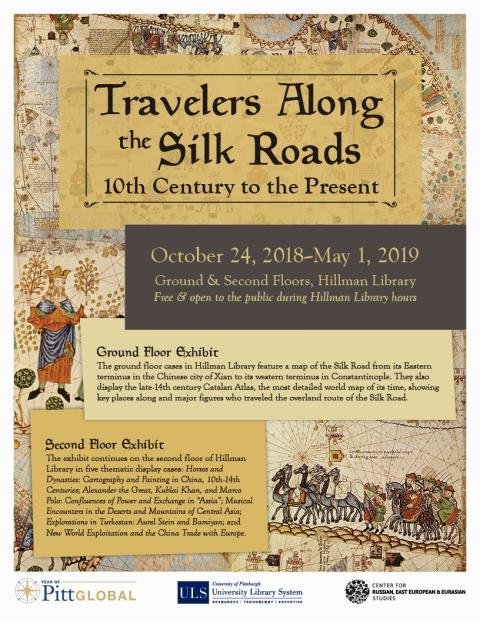
Free and Open to the Public during Hillman Library Hours
The term Silk Road, coined by 19th century German explorer Ferdinand von Richthofen, refers to a loose network of overland trade routes stretching from the Mediterranean to East Asia. Textiles, gems, spices, animals and even religions were all exchanged along this vast expanse, starting around 1,000 B.C. and continuing for millennia. For much of this time, most Silk Road traders coming from western Eurasia were Muslim, and they brought their beliefs and rich culture to millions of people.
A Crossroads of Ideas
While the Silk Road was a two-way route, most of its movement was eastward, carrying Buddhism, Zoroastrianism, Judaism, and later, Islam.
By the 8th century, Muslims stopped thinking of religion geographically and began seeking converts along the Silk Road. The benefits of conversion to such a widespread religion were many, as Muslims preferred trading with other Muslims.
Islamic scientific and medical advancements also had significant impact on Silk Road travelers. Chinese Buddhist traders adopted Islamic medical knowledge in wound healing and urinalysis. Muslims brought India their insights on astronomy, including a skepticism of the geocentric universe.
Cultural Exchange Along the Route
Influences from Buddhist China and other regions also affected radical changes in Islam. In the 12th century, abstract Islamic art suddenly started depicting human figures, long considered forbidden in Islam. Murals showing Buddhist statues and Indian narrative artwork started appearing in mosques, and Islamic art exploded with new techniques and figures. Chinese technologies, such as paper production and gunpowder, were transmitted to the West. Iran’s art in the Mongol period (13th and 14th centuries) is dramatically influenced by Chinese artistic traditions.
The Exhibit Design
The ground floor cases in Hillman Library feature a map of the Silk Road from its Eastern terminus in the Chinese city of Xian to its western terminus in Constantinople. They also display the late-14th century Catalan Atlas, the most detailed world map of its time, showing key places along and major figures who traveled the overland route of the Silk Road. The exhibit continues on the second floor of Hillman Library in five thematic display cases:
*Horses and Dynasties: Cartography and Painting in China, 10th-14th Centuries,
*Alexander the Great, Kublai Khan, and Marco Polo: Confluences of Power and Exchange in Assia,
*Musical Encounters in the Deserts and Mountains of Central Asia,
*Explorations in Turkestan: Aurel Stein and Bamiyan, and
*New World Exploitation and the China Trade with Europe.

